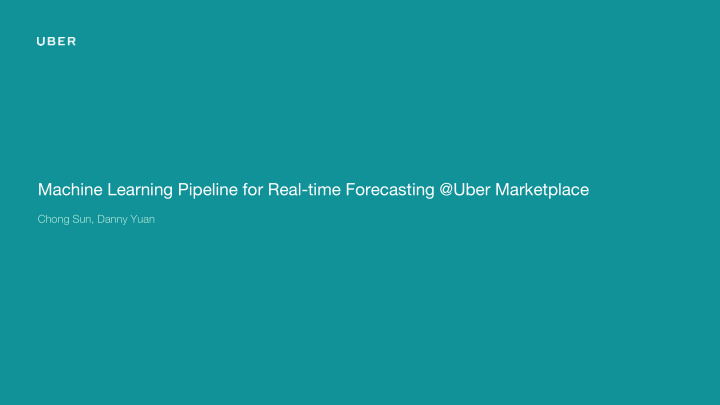



Machine Learning Pipeline for Real-time Forecasting @Uber Marketplace Chong Sun, Danny Yuan
Forecasting On A Global Scale
Cases For Real-Time Forecasting 01.01.17
Dynamic Pricing: Every Minute, Every Where
Dynamic Pricing: Every Minute, Every Where, Every Trip
We Forecast Time Series
We Forecast Time Series For Given Geo Locations
A Few Constraints More recent data has more signals ●
A Few Constraints Smaller areas have more noise ●
A Few Constraints Smaller areas have more noise ●
A Few Constraints More recent data has more signals ● Smaller areas have more noise ● We were rolling out business city by city with competing ● models FFT ○ Kalman Filter ○ Regressions ○ LSTM ○
First Pipeline
The Training Pipeline
The Training Pipeline
The Training Pipeline
The Training Pipeline - Airflow - PySpark - SciPy
The Training Pipeline - Cassandra
A Need for Fast Time Series DB - Cassandra - Elasticsearch
A Need For Streaming Data - Kafka
A Need For Unified Feature Engine
A Digression To Feature Engine
A Digression To Feature Engine - DataFlow API
A Digression To Feature Engine - Flink
A Digression To Feature Engine - Reusable functions - Schema driven - Discoverable by meta data
Inferencing Pipeline - Elasticsearch
Inferencing Pipeline
Real-time Visualization
Real-time Validation
A New Challenge: Model Management
More Signals
Scalable Model Evaluation
Metrics-as-a-Service
Model Lifecycle Management System (MLMS)
What if you're supporting 5+ teams, 10+ products with 4000+ model instances in production
Machine Learning Model Lifecycle
Machine Learning Model Lifecycle
Machine Learning Model Lifecycle
Machine Learning Model Lifecycle
Machine Learning Model Lifecycle
Machine Learning Model Lifecycle
Common Questions in the process ... Where am I going to save and serve my models? ● How do I keep track of the model metadata , e.g., training data used ? ● How can I easily find a previous model for testing and performance comparison? ● How can I automatically deploy a large scale number of models? ● When should I decide to trigger model re-training? ● How can I make sure I would not override any (production) models? ● How do we manage multiple dependent models? ● … ... ●
Common Questions in the process ... Where am I going to save and serve my models? ● How do I keep track of the model metadata , e.g., training data used ? ● How can I easily find a previous model for testing and performance comparison? ● How can I automatically deploy a large scale number of models? ● When should I decide to trigger model re-training? ● How can I make sure I would not override any (production) models? ● How do we manage multiple dependent models? ● … ... ● Model Lifecycle Management System (MLMS)
MLMS Design Principles Immutable Models ● Model Neutral ● Flexible ● Automated Dynamic Orchestration ●
MLMS Architecture
MLMS Architecture
MLMS Architecture
MLMS Architecture
MLMS Architecture
MLMS Architecture
MLMS Architecture
Machine Learning Model Lifecycle MLMS
Data Science and Engineering Work Flow
Data Scientists And Engineers Work In Lock Steps
Engineers Are Blocked Before Modeling Is Done
Time For Productization Is Often Squeezed
Rolling Out To All Cities Are Slow And Painful
Analysis of Bottlenecks Model Model Training and Serving Model Serving Exploration Implementation Production (DS, Python) (DS/Eng, Python/Go/Java) (Eng, Go/Java)
Analysis of Bottlenecks Model Model Training and Serving Model Serving Exploration Implementation Production (DS, Python) (DS/Eng, Python/Go/Java) (Eng, Go/Java) Restricted Models
Analysis of Bottlenecks Model Model Training and Serving Model Serving Exploration Implementation Production (DS, Python) (DS/Eng, Python/Go/Java) (Eng, Go/Java) DS → Eng Reimplementing Knowledge Model Transfer
Analysis of Bottlenecks Model Model Training and Serving Model Serving Exploration Implementation Production (DS, Python) (DS/Eng, Python/Go/Java) (Eng, Go/Java) DS/Eng Model Parity
Analysis of Bottlenecks Model Model Training and Serving Model Serving Exploration Implementation Production (DS, Python) (DS/Eng, Python/Go/Java) (Eng, Go/Java) DS/Eng Performance Debug
Key Insight: Can We All Enjoy One ML Ecosystem?
Unified Framework → Many Benefits Standardized project structure ● Out-of-box support of local and remote deployment ● Reusable algorithms and framework ● Design review between engineer and DS ● Code review between engineer and DS ● Who codes, who debugs ●
TensorFlow Client Dev (Python) Train (Python) Serve (Python/Java) Runtime TensorFlow Graph (C++) Model Model Training and Serving Model Serving Exploration Implementation Production (DS, Python) (DS/Eng, Python/Java) (Eng, Java) DS → Eng Eng Model Restricted DS/Eng Reimplementing Knowledge Performance Models Model Parity Model Transfer Debug
Enable DS to Write Production-Ready Code Tensorflow ● Efficient core ○ DS-friendly API ○ Engineers focusing on optimization and automation ● Parallelization of algorithms ○ End-to-end automation ○ Visualization ○ Integration ○ Project scaffolding ○
Example Build your own FTRL Use a framework
Building Tools Model Lifecycle Management System ● Hyperparameter Tuning ● Horovod for Distributed TensorFlow Training ●
Conclusion A fully automated MLMS is key to the success of complex ML ● systems A single framework for DS and engineers boosts productivity ● Building great tools is crucial to ML projects ●
Q & A
How do we make the forecasts?
Batch forecasting (2015) Batch Forecast Forecasts (ARIMA, FFT) Data Sources
Batch forecasting + Real-time Adjustment Batch Forecast Forecasts (ARIMA, FFT) Data Sources Realtime Adjust Consumer & Serve (Exponential Smoothing)
Issues Observed Not many ML libraries for Node.js Real-time component (Node.js) can not support CPU intensive computation Can not handle large scale data features in real-time Can not share code for batch and online processing
Second Generation of Forecasting Engine (Inspired by DataFlow and TensorFlow) Some interesting design principles: Both realtime and batch prediction: prediction is minute level, backtesting/evaluation requires batch processing
Machine Learning Model Lifecycle
MLMS Architecture Given model_name=linear_demand_model and city_id=1 When status == 'alerting' and time_sustained > 3 days Then retrainModel(model_name, city_id, model_version)
Recommend
More recommend